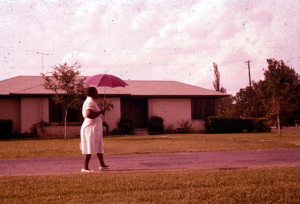- Bastiaan “Bart” M. Drees, Dec. 31, 2016
My family arrived in Dallas, Texas from the Netherlands in January of 1959. After a short time in an apartment near Preston Center Shopping Center, we moved into a rental house on Mimosa Lane in north Dallas. My parents were quick to meet many new friends from Dad’s work and the community, including Mr. and Mrs. Lichten (Dad’s boss and his wife who lived one block over; they were Jewish, and Mrs. Lichten got Mom to sing in the Jewish Church Choir, which she did as long as they lived in Dallas), Marian Ellis (a realtor who was helping us shop for a house to buy and who taught us about saying “Ma’am”, “Yes, dear”, “Uhm Uhm” and other Texan idioms). Through them, my parents were able to find an agency that hired out maids.
In my family, servants and maids were not uncommon. I understand that my grandparents on my dad’s side of the family in the Netherlands usually had a housekeeper. My mom’s parents had servants during their years in Indonesia (Dutch East Indies) before World War II broke out. The family story is that after a big meal when Mom’s family all sat around the table, her mom would call out, “Ankat!” for the servant to come get the dishes and clear the table. So, it was an accepted part of the culture in 1960 to hire a negro maid. Her name was Ollie.
Ollie came to the house weekly to clean and help Mom out with chores. They developed a nice relationship that soon grew into a friendship. Just like in the book, The Help (Kathryn Stockett, 2011), our maid would travel from downtown to this north Dallas suburb by bus and walk the rest of the way from the bus stop to the house. She was always dressed in formal maids’ attire: a white dress uniform.

My parents were set on becoming “Americanized” and assimilating into the culture as fast as they could. Compared to Rotterdam, Dallas was still pretty much the wild west frontier town we had envisioned with cowboys, horses, ranches, open countryside, and only one bookstore in the whole city. As a family, we were totally oblivious to race relations and racism when we arrived. As kids, we were taught to respect every human being and to judge them by their words and actions (emphasis on character!), not by skin color or other (cultural) differences.
Perhaps because Ollie recognized our family’s naiveté, or perhaps because her relationship with our family differed from her American customers, Ollie asked us to come to church with her. My parents eagerly accepted.
On the night of the service, we all dressed up in our finest clothes. My sister (8 year old Frieda), brother (9-year-old Herman), and I (7 years old) piled into the back seat of our 1959 blue Chevrolet station wagon and drove downtown. These were different neighborhoods than we had experienced before, but this did not stop us. We arrived at the church and were warmly greeted by the all black congregation. We were given seats of honor in the first row of pews. We were the only white people in the church.
The service began, and the sermon was given. Then some hymns were sung, and more sermons and prayers followed. Then the singing resumed; this time with more fervor and emotions. This continued to escalate. Music got louder. Soon, some of the congregation rose to their feet. Then more people arose. They began to sway to the music and raise their hands into the air. Soon, the whole congregation seemed to be moved by the gospel songs. Some broke down, fainting in the isles, overcome by the spiritual experience, and had to be removed from the room.
My eyes could not have been open wider. This unbelievable and unique experience had a major impact on our early Texas childhood memories. To this day, my brother, sister, and I still feel honored to have been asked to share in this opportunity and were honored to receive it.
Racism in Dallas in my childhood was part of the culture and community in which we were raised we grew up in. I still remember some of the “jokes” shared among acquaintances. Although less so today, the reality is that bigotry is still here in America.
When my family finally bought a home a few blocks over on Stichter Avenue, we quickly met our new neighbors. There were a lot of kids our age (Mike, Pat, and Tom Flanery; Sam, Walter, and Linda Morgan; Mary and Jim Cronkheit), and we formed a club or gang, meeting in the tree house complex in our back yard, a.k.a. Fort Drees.
Our next-door neighbors were the Jamesons. Mr. Jameson was the principal for an elementary school. Mrs. Jameson stayed home taking care of her special needs daughter, Caroline, all of her life. Mr. Jameson was a racial segregationist and shared his views openly with my dad in the driveway one day. My day voiced his opinion back… strongly! I’m proud of my dad, and I hold dear to the ideas about the value of people that they taught us. . I remember Ollie with fondness and can still hear my mom calling out to her with her high-pitched sing-song voice: “Ollie!!!” She introduced us to the rich cultural heritage that represents America at its best